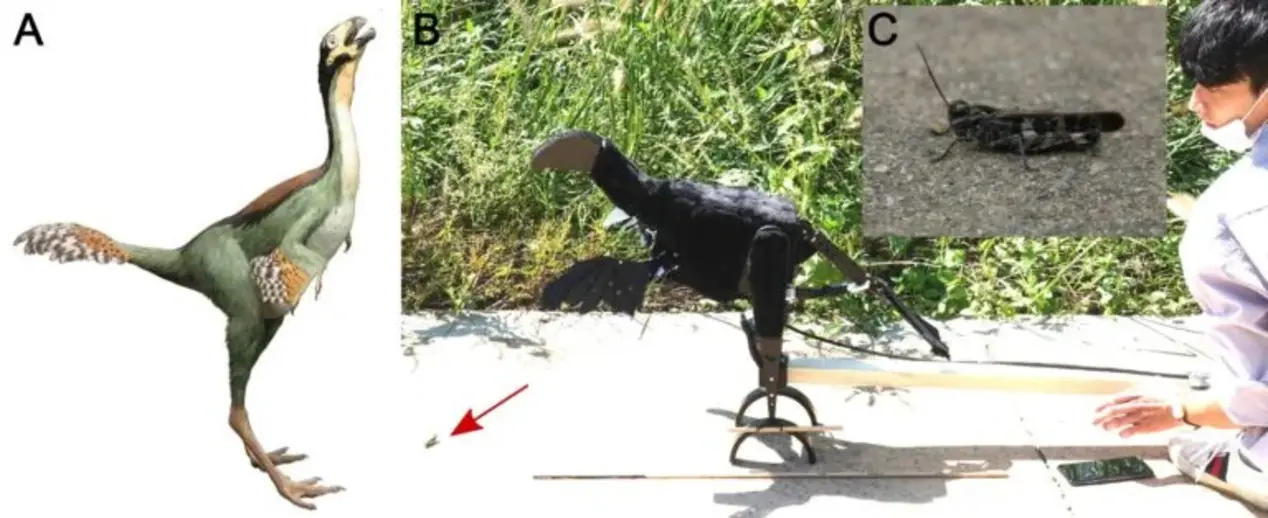Scientists learned why flightless dinosaurs needed “wings”
- January 26, 2024
- 0
For a long time, paleontologists could not understand how dinosaurs that could not fly were able to use their feather-covered front limbs – they were called protowings due
For a long time, paleontologists could not understand how dinosaurs that could not fly were able to use their feather-covered front limbs – they were called protowings due

For a long time, paleontologists could not understand how dinosaurs that could not fly were able to use their feather-covered front limbs – they were called protowings due to their resemblance to real wings. To shed light on this question, South Korean researchers created “Robopteryx”, a real robot-dinosaur that mimics the movement of the bipedal “winged” caudipteryx (Caudipteryx), which “hunts” live grasshoppers.
Many dinosaurs were feathered; Even flightless lizards could have feathers all over their bodies and tails. Some even had small prows covered with stiff feathers, similar to the outline feathers found today on the wings and tails of modern birds. Contour feathers cover the entire body of the latter and have a well-developed dense shaft. This type of feathers is very different from the downy, soft ones.
Today, the only dinosaur group known to have the outline feathers necessary for flight. These are foam birds of prey (Pennoraptora), lived in the Jurassic period. They also had proto-wings, whose functions are still unclear because they could not fly. Many hypotheses have been put forward on this subject. According to one of them, such protowings helped lizards hunt and frightened prey, which may have contributed to the bright plumage. Similar tactics are used by modern birds such as the California ground cuckoo or the polyphonic mockingbird. It is known that contrasting feathers can scare away “enemies”.
To test this assumption, scientists from Seoul National University (South Korea) created a real robot “Robopteryx”, which is a morphological model of the bipedal dinosaur Caudipteryx (caudipteryx), similar in size to modern peacocks.
These dinosaurs lived in northeastern China 120-125 million years ago. The name of the lizard is translated as “tail feather”, because on its tail there were long hairs, up to 20 centimeters in length, arranged in the form of a fan. Caudipteryxes could not fly: the “wings” were too short for flight, and the feathers on them were straight and symmetrical (you need the asymmetric shape of the feather to fly).
Scientists equipped Robopteryx with motors and programmed it to mimic the movements of the wings and tail, as in the red-tailed flycatcher, a representative of songbird species that are distant relatives of foam raptors. Even real live grasshoppers “participated” in the experiment. They belong to the ancient order Orthoptera, which probably existed at the time of the foam raptors.
The experiment showed that locusts escaped cover 90 percent of the time when Robopteryx flapped its “wings” fully, but only 35 percent of the time when it flexed its wings slightly. In addition, white contrasting spots on the wings and tail contributed to the success of Caudipteryx, which was “reborn from the ashes” (when scientists made the wings and tail of “Robopteryx” spotted, grasshoppers escaped more often). The results of the research were presented in the journal Scientific Reports.
Source: Port Altele
As an experienced journalist and author, Mary has been reporting on the latest news and trends for over 5 years. With a passion for uncovering the stories behind the headlines, Mary has earned a reputation as a trusted voice in the world of journalism. Her writing style is insightful, engaging and thought-provoking, as she takes a deep dive into the most pressing issues of our time.